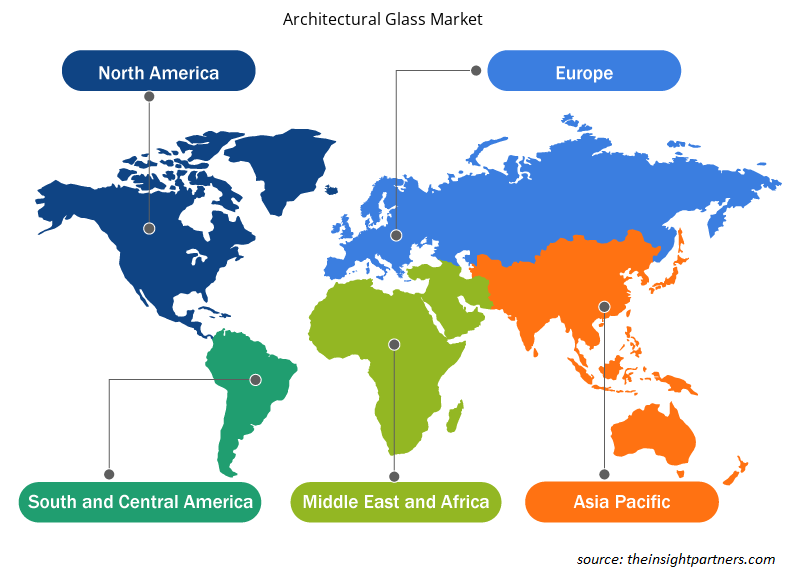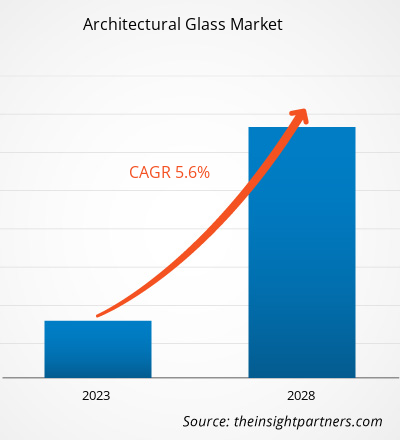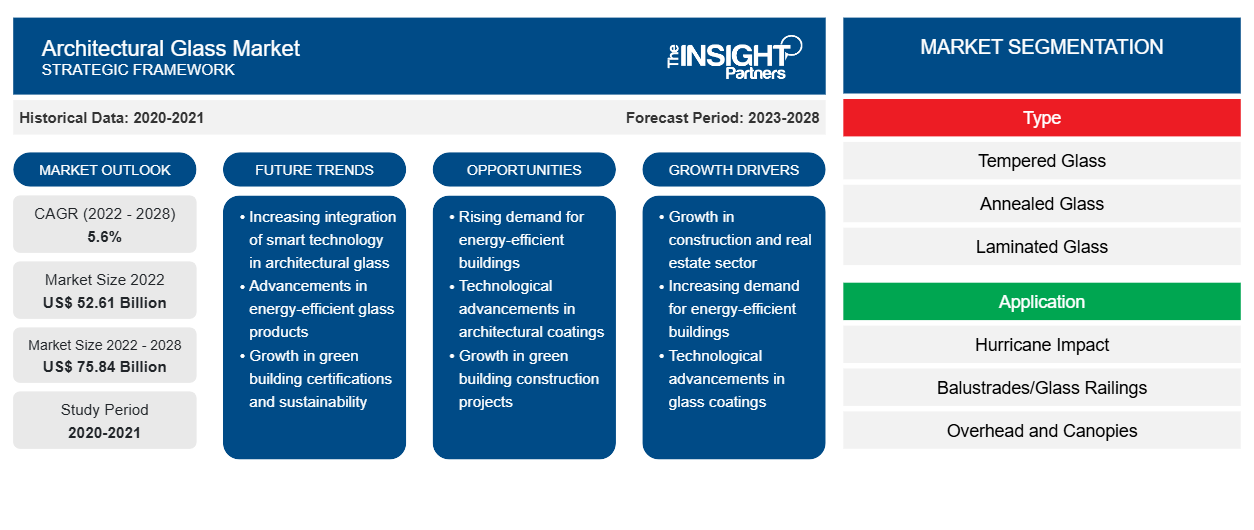La taille du marché du verre architectural devrait passer de 52 608,27 millions USD en 2022 à 75 837,41 millions USD en 2028 ; elle devrait croître à un TCAC de 5,6 % de 2022 à 2028.
Le verre architectural est un matériau de construction utilisé comme vitrage transparent dans les fenêtres, les portes de maisons et de bureaux, les murs extérieurs, entre autres. L'urbanisation croissante contribue à la croissance des activités de construction à travers le monde. La croissance démographique croissante, la migration des populations des zones rurales vers les zones urbaines à la recherche d'opportunités de carrière et les investissements commerciaux stratégiques stimulent le secteur de la construction, stimulant ainsi la croissance du marché du verre architectural .
Impact de la pandémie de COVID-19 sur le marché du verre architectural
En 2020, plusieurs industries ont dû ralentir leurs opérations en raison des perturbations des chaînes de valeur et d'approvisionnement causées par la fermeture des frontières nationales et internationales. La pandémie de COVID-19 a eu des répercussions négatives sur les économies et les industries en raison des confinements, des interdictions de voyager et des fermetures d'entreprises. Les perturbations des chaînes d'approvisionnement des principales matières premières et les irrégularités dans les processus de fabrication dues aux restrictions imposées par les autorités gouvernementales ont eu un impact direct sur l'industrie des produits chimiques et des matériaux, ce qui a entravé la production et la demande de matériaux de construction. Ces facteurs ont eu un impact négatif sur le marché du verre architectural pendant la pandémie de COVID-19. Cependant, en 2021, le marché a connu une reprise positive lorsque les gouvernements ont annoncé l'assouplissement des restrictions précédemment imposées. Les fabricants ont été autorisés à travailler à pleine capacité, tirant parti de leur rentabilité. Ce facteur devrait stimuler le marché dans les années à venir. Par exemple, selon Eurostat, après une baisse sans précédent en mars et avril (-25,9 %), l'activité de construction dans l'Union européenne a augmenté de 20,4 % en mai 2020. Elle a récupéré une partie des pertes de la crise. Depuis lors, l'activité de construction a augmenté au cours de la plupart des mois, mais pas de manière très dynamique. En janvier 2022, le niveau de production n'était supérieur que de 1,9 % à celui de février 2020.
Personnalisez ce rapport en fonction de vos besoins
Vous bénéficierez d'une personnalisation gratuite de n'importe quel rapport, y compris de certaines parties de ce rapport, d'une analyse au niveau des pays, d'un pack de données Excel, ainsi que d'offres et de remises exceptionnelles pour les start-ups et les universités.
-
Obtenez les principales tendances clés du marché de ce rapport.Cet échantillon GRATUIT comprendra une analyse de données, allant des tendances du marché aux estimations et prévisions.
Informations sur le marché
Demande croissante de verre coloré et imprimé
Avec la croissance économique, l'augmentation du niveau de vie et la modernisation de la population mondiale, l'utilisation de verre décoratif, tel que le verre imprimé et coloré, dans la conception des intérieurs des bâtiments résidentiels et commerciaux augmente. La demande de verre sérigraphié dans le secteur de la construction augmente car il offre divers avantages esthétiques par rapport aux matériaux de construction traditionnels. Le verre sérigraphié étend ses utilisations dans les applications industrielles, commerciales et architecturales telles que les vitrines, l'aménagement paysager extérieur des bâtiments, les cloisons d'espace architectural, le verre mosaïque, la décoration de meubles et d'autres objets 3D. De telles avancées dans la fabrication de variétés de verre devraient encore stimuler la demande de verre architectural.
Informations sur les types
En fonction du type, le marché du verre architectural est segmenté en verre trempé , verre recuit, verre feuilleté et autres. Le segment feuilleté devrait enregistrer le TCAC le plus élevé au cours de la période de prévision. Le verre feuilleté est une bonne alternative au verre traditionnel, car il offre une structure rigide, robuste et durable et fournit une couche solide et transparente. Il est utilisé dans les bâtiments à haut risque d'ouragans ou d'autres catastrophes naturelles, dans les fenêtres des bâtiments résidentiels et commerciaux à haut risque d'effraction, dans les vitrines pour objets de valeur tels que les bijoux, les aquariums ou les enclos pour animaux, les sols en verre, les escaliers en verre, les puits de lumière et les toits en verre. De plus, en raison de la demande croissante de sécurité, de réduction du bruit, de résistance aux éclats et de protection contre les intempéries, le marché devrait connaître une croissance régulière au cours de la période de prévision.CAGR during the forecast period. Laminated glass is a good alternative to traditional glass, as it offers a rigid, robust, and durable structure and provides a solid, transparent layer. It is used in buildings that are at high risk of hurricanes or other natural disasters, in windows of residential and commercial buildings at higher risk of break-ins, in display cabinets for valuables such as jewelry, aquariums or animal enclosures, glass floors, glass stairs, skylights, and glass roofs. Additionally, owing to the rising demand for security, sound reduction, shatter resistance, and protection from adverse weather conditions, the market is expected to witness steady growth during the forecast period.
Informations sur les applications
En fonction des applications, le marché du verre architectural est segmenté en verre résistant aux ouragans, balustrades/garde-corps en verre, auvents et auvents, verre de sécurité/pare-balles, acoustique, verre décoratif/coloré, façades structurelles et autres. Le segment des façades structurelles détenait la plus grande part du marché en 2021. Dans les façades structurelles , le verre architectural est largement utilisé dans les revêtements muraux en verre et les cloisons murales en verre. Le revêtement mural est utilisé pour fournir un certain degré d'isolation thermique et de résistance aux intempéries, et pour améliorer l'apparence des bâtiments. Le revêtement en verre est une technique largement utilisée en architecture où des vitres sont utilisées sur la surface extérieure des bâtiments. Le verre trempé est le type de verre le plus courant utilisé dans les cloisons murales. Ce verre est trempé en le chauffant, ce qui rend le verre quatre à cinq fois plus résistant et plus durable que le verre recuit. Ces facteurs devraient stimuler le segment.
Les principaux acteurs du marché du verre architectural sont AGC Inc, Compagnie de Saint-Gobain SA, Guardian Industries Holdings LLC, Nippon Sheet Glass Co Ltd, Qingdao Morn Building Materials Co Ltd, Asahi India Glass Ltd, Turkiye Sise ve Cam Fabrikalari AS, Schott AG, Jinjing (Group) Co Ltd et Vitro SAB de CV. Ces acteurs se concentrent sur la fourniture de produits de haute qualité pour répondre aux demandes des clients. Ils se concentrent également sur des stratégies telles que les investissements dans les activités de recherche et développement et le lancement de nouveaux produits.
Aperçu régional du marché du verre architectural
Les tendances et facteurs régionaux influençant le marché du verre architectural tout au long de la période de prévision ont été expliqués en détail par les analystes d’Insight Partners. Cette section traite également des segments et de la géographie du marché du verre architectural en Amérique du Nord, en Europe, en Asie-Pacifique, au Moyen-Orient et en Afrique, ainsi qu’en Amérique du Sud et en Amérique centrale.

- Obtenez les données régionales spécifiques au marché du verre architectural
Portée du rapport sur le marché du verre architectural
| Attribut de rapport | Détails |
|---|---|
| Taille du marché en 2022 | 52,61 milliards de dollars américains |
| Taille du marché d'ici 2028 | 75,84 milliards de dollars américains |
| Taux de croissance annuel composé mondial (2022-2028) | 5,6% |
| Données historiques | 2020-2021 |
| Période de prévision | 2023-2028 |
| Segments couverts |
Par type
|
| Régions et pays couverts |
Amérique du Nord
|
| Leaders du marché et profils d'entreprises clés |
|
Densité des acteurs du marché du verre architectural : comprendre son impact sur la dynamique commerciale
Le marché du verre architectural connaît une croissance rapide, tirée par la demande croissante des utilisateurs finaux en raison de facteurs tels que l'évolution des préférences des consommateurs, les avancées technologiques et une plus grande sensibilisation aux avantages du produit. À mesure que la demande augmente, les entreprises élargissent leurs offres, innovent pour répondre aux besoins des consommateurs et capitalisent sur les tendances émergentes, ce qui alimente davantage la croissance du marché.
La densité des acteurs du marché fait référence à la répartition des entreprises ou des sociétés opérant sur un marché ou un secteur particulier. Elle indique le nombre de concurrents (acteurs du marché) présents sur un marché donné par rapport à sa taille ou à sa valeur marchande totale.
Les principales entreprises opérant sur le marché du verre architectural sont :
- AGC Inc
- Compagnie de Saint-Gobain SA
- Guardian Industries Holdings LLC
- Nippon Sheet Glass Co., Ltd.
- Qingdao Morn Matériaux de construction Co., Ltd.
Avis de non-responsabilité : les sociétés répertoriées ci-dessus ne sont pas classées dans un ordre particulier.

- Obtenez un aperçu des principaux acteurs du marché du verre architectural
Rapports en vedette
- Tendances industrielles progressistes sur le marché du verre architectural pour aider les acteurs à développer des stratégies efficaces à long terme
- Stratégies de croissance commerciale adoptées par les entreprises pour assurer leur croissance sur les marchés développés et en développement
- Analyse quantitative du marché du verre architectural de 2020 à 2028
- Estimation de la demande mondiale en verre architectural
- Analyse des cinq forces de Porter pour illustrer l'efficacité des acheteurs et des fournisseurs de verre architectural
- Développements récents pour comprendre le scénario concurrentiel du marché
- Tendances et perspectives du marché, ainsi que facteurs qui stimulent et freinent la croissance du marché du verre architectural
- Aide à la prise de décision en mettant en évidence les stratégies de marché qui sous-tendent l'intérêt commercial
- La taille du marché du verre architectural à différents niveaux
- Aperçu détaillé et segmentation du marché, ainsi que de la dynamique du secteur de la construction
- Taille du marché du verre architectural dans diverses régions avec des opportunités de croissance prometteuses
Profils d'entreprise
- AGC Inc
- Compagnie de Saint-Gobain SA
- Guardian Industries Holdings LLC
- Nippon Sheet Glass Co., Ltd.
- Qingdao Morn Matériaux de construction Co., Ltd.
- Asahi India Glass Ltd
- Turkiye Sise et Cam Fabrikalari AS
- Schott AG
- Jinjing (Groupe) Co., Ltd.
- Vitro SAB de CV
- Analyse historique (2 ans), année de base, prévision (7 ans) avec TCAC
- Analyse PEST et SWOT
- Taille du marché Valeur / Volume - Mondial, Régional, Pays
- Industrie et paysage concurrentiel
- Ensemble de données Excel
Rapports récents
Rapports connexes
Témoignages
Raison d'acheter
- Prise de décision éclairée
- Compréhension de la dynamique du marché
- Analyse concurrentielle
- Connaissances clients
- Prévisions de marché
- Atténuation des risques
- Planification stratégique
- Justification des investissements
- Identification des marchés émergents
- Amélioration des stratégies marketing
- Amélioration de l'efficacité opérationnelle
- Alignement sur les tendances réglementaires























 Obtenez un échantillon gratuit pour - Marché du verre architectural
Obtenez un échantillon gratuit pour - Marché du verre architectural